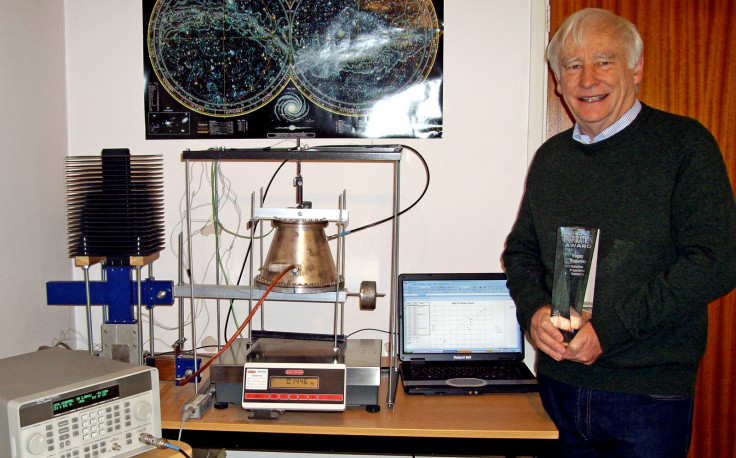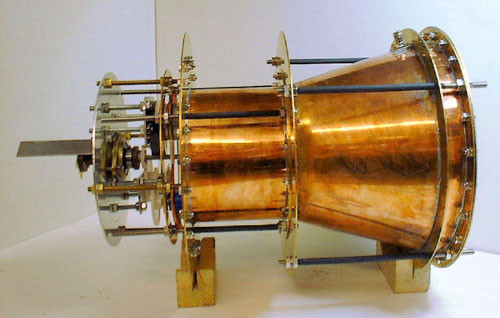EmDrive: Nasa Eagleworks confirms paper on controversial space propulsion is under peer review
The EmDrive is the invention of British scientist Roger Shawyer.
Nasa's Eagleworks Laboratories has confirmed that it currently has a paper on the highly controversial space propulsion technology EmDrive going through the peer review process, which seems to indicate that the researchers are confident of having significant results to reveal.
"The Eagleworks Lab is NOT dead and we continue down the path set by our NASA management. Past that I can't say more other than to listen to Dr Rodal on this topic, and please have patience about when our next EW paper is going to be published. Peer reviews are glacially slow," Eagleworks engineer Paul March wrote on the Nasa Spaceflight forum on 17 March.

The EmDrive is the invention of British scientist Roger Shawyer, who proposed in 1999 that based on the theory of special relativity, electricity converted into microwaves and fired within a closed cone-shaped cavity causes the microwave particles to exert more force on the flat surface at the large end of the cone (i.e. there is less combined particle momentum at the narrow end due to a reduction in group particle velocity), thereby generating thrust.
His critics say that according to the law of conservation of momentum, his theory cannot work as in order for a thruster to gain momentum in one direction, a propellant must be expelled in the opposite direction, and the EmDrive is a closed system.
However, Shawyer claims that following fundamental physics involving the theory of special relativity, the EmDrive does in fact preserve the law of conservation of momentum and energy.
2015: The year when EmDrive came back into the spotlight
After years of being ridiculed by the international scientific community, Roger Shawyer and the EmDrive suddenly rocketed into the news in 2015.

March posted information to the Nasa Spaceflight forum about successful tests conducted on the EmDrive in a vacuum that yielded thrust results that could not be explained by external interference.
As the Eagleworks Laboratories is to Nasa essentially what the secretive Google X "moonshot" R&D lab is to Google/Alphabet, after the April report was released, March posted that Nasa was placing a tighter control over what content its Eagleworks' researchers released to the public, as Nasa is not yet ready to place its official stamp of approval on a technology many still believe doesn't even work.
But following the Nasa Eagleworks furore, in July Dr Martin Tajmar, Chair for Space Systems at the Dresden University of Technology's Institute of Aerospace Engineering, who is well known for debunking space propulsion systems, presented a paper showing that he and his researchers were able to measure effects similar to the EmDrive. However, the researchers were not able to establish the nature of the thrust measurement, or define if there were any other factors obscuring their results.
In the same month, Shawyer also exclusively revealed to IBTimes UK that he finally had a paper on the second generation of the EmDrive peer-reviewed and accepted by the International Academy of Astronautics (IAA).
Nasa Eagleworks: We've been quiet because we're working on it
The last update we've had was in November 2015, when March took to Nasa Spaceflight again to announce that they were still continuing to discover signals of thrust which could not be explained in their EmDrive tests, even with a second generation magnetic damper added to the EmDrive to help reduce any stray magnetic fields in the vacuum chamber by an order of magnitude.
In the end, March stated that the researchers were now working on a new integrated analytical tool to help separate EmDrive thrust pulse waveform contributions from the thermal expansion interference, as well as upgrading their EmDrive to include vacuum-capable RF amplifiers with power ranges of up to 125W, and to design a new tapered cavity analytically determined to be in the 0.1 N/kW range.
The finished product would also be subjected to independent verification and validation at Glenn Research Center, the Jet Propulsion Laboratory, and the Johns Hopkins University Applied Physics Laboratory.
March's latest post highlighting the Eagleworks Lab paper was written in defence to criticism on the Nasa Spaceflight forum claiming that the Eagleworks project was actually dead in the water. But in his post, March also endorsed the technical information and insights posted by forum member José Rodal, an independent scientist and inventor who helped to publicise Eagleworks' research in April 2015. Rodal is building his own version of the Nasa aluminium frustum, while pointing out how differences in dielectric materials, among other things, can affect how the results are interpreted.
© Copyright IBTimes 2024. All rights reserved.






















